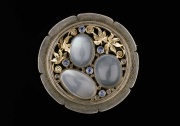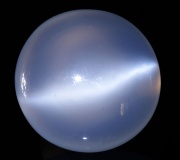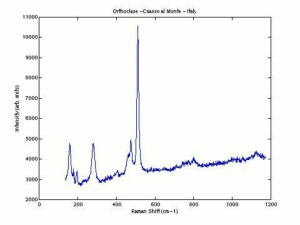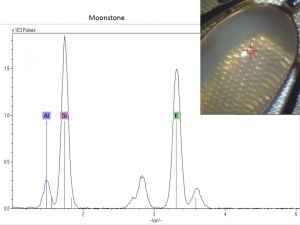Difference between revisions of "Moonstone"
| (10 intermediate revisions by the same user not shown) | |||
| Line 1: | Line 1: | ||
| − | [[File:1986.265-SC164691.jpg|thumb| | + | [[File:1986.265-SC164691.jpg|thumb|Brooch<br>MFA Acc. #: 1986.265]] |
== Description == | == Description == | ||
| − | + | [[File:Moonstone cabochon.jpg|thumb|'Moonstone cabochon from Minas Gerais, Brazil]] | |
| − | An opalescent [[orthoclase|orthoclase]] feldspar group mineral (sodium potassiuim aluminum silicate) that is used as a gemstone. Moonstones are semitransparent or translucent stones that are usually a milky white with a pale blue luster. Occasionally other colors, such as white, gray, orange, pink, yellow or pale green are found. Their | + | An opalescent [[orthoclase|orthoclase]] feldspar group mineral (sodium potassiuim aluminum silicate) that is used as a gemstone. Moonstones are semitransparent or translucent stones that are usually a milky white with a pale blue luster. Occasionally other colors, such as white, gray, orange, pink, yellow or pale green are found. Their pearly or opalescent sheen is a visual effect caused by light diffraction within a micro-structure of regular feldspar layers (lamellae). Moonstones have a hardness of 6 to 6.5 but they are fragile because they cleave readily along the lamination axis. Usually cut as a cabochon, moonstones were used in Roman jewelry from about 100 CE and were popular in 20th century Art Nouveau jewely. Moonstones are mined in Myanmar (formerly Burma), Sri Lanka (Dumbara District), and India. They are found in potassium ([[orthoclase]]) feldspars, while [[plagioclase|plagioclase]] feldspars produce [[sunstone|sunstones]]. Iridescent sunstones, such as from peristerite and [[labradorite|labradorite]], are also sometimes called moonstones. |
== Synonyms and Related Terms == | == Synonyms and Related Terms == | ||
precious moonstone; peristerite; labradorite; pierre de lune (Fr.); Mondstein (Deut.); maansteen (Ned.) | precious moonstone; peristerite; labradorite; pierre de lune (Fr.); Mondstein (Deut.); maansteen (Ned.) | ||
| + | [[[SliderGallery rightalign|Orthoclaseitaly1.jpg~Raman (U of Parma)|Moonstone XRF.jpg~XRF (MFA)]]] | ||
| + | ==Physical and Chemical Properties== | ||
| + | * Monoclinic system; twinned crystals common | ||
| + | * Perfect cleavage in two directions (right angles) | ||
| + | * Fracture = uneven to splintery | ||
| + | * Luster = vitreous | ||
| + | * Streak = white | ||
| + | * Pleochroism = usually none; may be weak in yellow stones | ||
| + | * Fluorescence = inert to weak; different shades of body color | ||
| + | * Show adularescence and/or aventurescence | ||
| + | * Dispersion = strong | ||
| + | * Inclusions = centipede-like inclusions; twinning planes; possible oriented needles | ||
{| class="wikitable" | {| class="wikitable" | ||
| Line 17: | Line 29: | ||
|- | |- | ||
! scope="row"| Density | ! scope="row"| Density | ||
| − | | 2.56-2.76 | + | | 2.56-2.76 g/ml |
|- | |- | ||
! scope="row"| Refractive Index | ! scope="row"| Refractive Index | ||
| 1.518-1.526 | | 1.518-1.526 | ||
| + | |- | ||
| + | ! scope="row"| Birefringence | ||
| + | | 0.005 - 0.008 | ||
|} | |} | ||
| − | |||
| − | |||
== Comparisons == | == Comparisons == | ||
| Line 29: | Line 42: | ||
[[media:download_file_421.pdf|Properties of Common Gemstones]] | [[media:download_file_421.pdf|Properties of Common Gemstones]] | ||
| − | + | == Resources and Citations == | |
| − | + | * Mineralogy Database: [http://www.webmineral.com/data/Orthoclase.shtml Orthoclase] | |
| − | == | + | * Gem Identification Lab Manual, Gemological Institute of America, 2016. |
| − | |||
* Jack Odgen, ''Jewellery of the Ancient World'', Rizzoli International Publications Inc., New York City, 1982 | * Jack Odgen, ''Jewellery of the Ancient World'', Rizzoli International Publications Inc., New York City, 1982 | ||
| − | |||
* R.F.Symmes, T.T.Harding, Paul Taylor, ''Rocks, Fossils and Gems'', DK Publishing, Inc., New York City, 1997 | * R.F.Symmes, T.T.Harding, Paul Taylor, ''Rocks, Fossils and Gems'', DK Publishing, Inc., New York City, 1997 | ||
| − | + | * ''Encyclopedia Britannica'', http://www.britannica.com Comment: "moonstone" [Accessed March 4, 2002] | |
| − | * ''Encyclopedia Britannica'', http://www.britannica.com Comment: "moonstone" | + | * Wikipedia: [https://en.wikipedia.org/wiki/Orthoclase Orthoclase] (Accessed Sept. 14, 2005 and Dec 2022) |
| − | |||
| − | * Wikipedia | ||
| − | |||
* Yasukazu Suwa, ''Gemstones: Quality and Value, Volume 1'', Sekai Bunka Publishing Inc., Tokyo, 1999 Comment: RI=1.518-1.526; Specific gravity=2.58 | * Yasukazu Suwa, ''Gemstones: Quality and Value, Volume 1'', Sekai Bunka Publishing Inc., Tokyo, 1999 Comment: RI=1.518-1.526; Specific gravity=2.58 | ||
| − | |||
* Michael O'Donoghue and Louise Joyner, ''Identification of Gemstones'', Butterworth-Heinemann, Oxford, 2003 | * Michael O'Donoghue and Louise Joyner, ''Identification of Gemstones'', Butterworth-Heinemann, Oxford, 2003 | ||
| − | |||
* G.S.Brady, ''Materials Handbook'', McGraw-Hill Book Co., New York, 1971 Comment: p. 316 | * G.S.Brady, ''Materials Handbook'', McGraw-Hill Book Co., New York, 1971 Comment: p. 316 | ||
| − | |||
* Random House, ''Webster's Encyclopedic Unabridged Dictionary of the English Language'', Grammercy Book, New York, 1997 | * Random House, ''Webster's Encyclopedic Unabridged Dictionary of the English Language'', Grammercy Book, New York, 1997 | ||
| − | |||
* ''The American Heritage Dictionary'' or ''Encarta'', via Microsoft Bookshelf 98, Microsoft Corp., 1998 | * ''The American Heritage Dictionary'' or ''Encarta'', via Microsoft Bookshelf 98, Microsoft Corp., 1998 | ||
Latest revision as of 13:43, 4 January 2023
Description
An opalescent Orthoclase feldspar group mineral (sodium potassiuim aluminum silicate) that is used as a gemstone. Moonstones are semitransparent or translucent stones that are usually a milky white with a pale blue luster. Occasionally other colors, such as white, gray, orange, pink, yellow or pale green are found. Their pearly or opalescent sheen is a visual effect caused by light diffraction within a micro-structure of regular feldspar layers (lamellae). Moonstones have a hardness of 6 to 6.5 but they are fragile because they cleave readily along the lamination axis. Usually cut as a cabochon, moonstones were used in Roman jewelry from about 100 CE and were popular in 20th century Art Nouveau jewely. Moonstones are mined in Myanmar (formerly Burma), Sri Lanka (Dumbara District), and India. They are found in potassium (Orthoclase) feldspars, while Plagioclase feldspars produce sunstones. Iridescent sunstones, such as from peristerite and Labradorite, are also sometimes called moonstones.
Synonyms and Related Terms
precious moonstone; peristerite; labradorite; pierre de lune (Fr.); Mondstein (Deut.); maansteen (Ned.)
Physical and Chemical Properties
- Monoclinic system; twinned crystals common
- Perfect cleavage in two directions (right angles)
- Fracture = uneven to splintery
- Luster = vitreous
- Streak = white
- Pleochroism = usually none; may be weak in yellow stones
- Fluorescence = inert to weak; different shades of body color
- Show adularescence and/or aventurescence
- Dispersion = strong
- Inclusions = centipede-like inclusions; twinning planes; possible oriented needles
| Formula | (Na,K)AlSi3O8 |
|---|---|
| Mohs Hardness | 6.0 - 6.5 |
| Density | 2.56-2.76 g/ml |
| Refractive Index | 1.518-1.526 |
| Birefringence | 0.005 - 0.008 |
Comparisons
Properties of Common Gemstones
Resources and Citations
- Mineralogy Database: Orthoclase
- Gem Identification Lab Manual, Gemological Institute of America, 2016.
- Jack Odgen, Jewellery of the Ancient World, Rizzoli International Publications Inc., New York City, 1982
- R.F.Symmes, T.T.Harding, Paul Taylor, Rocks, Fossils and Gems, DK Publishing, Inc., New York City, 1997
- Encyclopedia Britannica, http://www.britannica.com Comment: "moonstone" [Accessed March 4, 2002]
- Wikipedia: Orthoclase (Accessed Sept. 14, 2005 and Dec 2022)
- Yasukazu Suwa, Gemstones: Quality and Value, Volume 1, Sekai Bunka Publishing Inc., Tokyo, 1999 Comment: RI=1.518-1.526; Specific gravity=2.58
- Michael O'Donoghue and Louise Joyner, Identification of Gemstones, Butterworth-Heinemann, Oxford, 2003
- G.S.Brady, Materials Handbook, McGraw-Hill Book Co., New York, 1971 Comment: p. 316
- Random House, Webster's Encyclopedic Unabridged Dictionary of the English Language, Grammercy Book, New York, 1997
- The American Heritage Dictionary or Encarta, via Microsoft Bookshelf 98, Microsoft Corp., 1998



